10.2: Later Etruscans
- Page ID
- 108646
Later Etruscan Sculpture & Painting
By Boundless Art History
Etruscan Bronze Sculptures
During its Classical period, from 480 to 300 BCE, Etruscan art was known for its hollow cast bronze sculptures and smaller utilitarian objects. Objects such as mirrors and cistae were engraved or incised with rich imagery that was made noticeable by a white substance inserted into the outlines and contour lines.
The Etruscan sculptures of human subjects range from naturalistic to exaggerated, almost modernist, forms, and the mythical creatures from the Greek and Eastern traditions found their way into their subject matter. In total, Etruscan sculpture incorporates a variety of cultural styles and motifs, including Orientalizing, Archaic, and Classical.
Very few Etruscan bronze sculptures survived because they were melted down in the following centuries to be used for other purposes.
Lost-Wax Casting
Also known by its French name, cire perdue, lost-wax casting is the oldest method of producing metal sculptures. Although any material that can be liquified and subsequently solidified can be cast, metal is the most common. Of all metals, bronze is the most commonly cast.
In lost-wax casting, the sculptor begins by making a clay mold of the intended sculpture, coats it in wax, and applies an outer layer of plaster to it, fastening metal rods to hold the shell in place and wax rods to vent the mold. Intense heat is then applied, causing the wax to melt and flow out of the mold. This step leaves open channels into which molten metal is poured.
When the metal has cooled and hardened, the mold is broken, the sculpture is removed, and the holes left from the pins and rods are filled and smoothed. Finally, the sculpture is polished and ready for display. Because the mold must be destroyed, sculptors use the lost-wax method to produce one-of-a-kind sculptures.
Chimera of Arezzo
The bronze statue of the Chimera, discovered in the city of Arezzo in 1553, has recently been judged as a forgery (see Figure 10.2.1). The reasoning rests more on the fact that there are no comparable existing Etruscan sculptures than on scientific testing.
An inscription on the right foreleg marks the bronze as a votive offering to the supreme Etruscan god, Tinia (comparable to Roman Jupiter). The sculpture depicts the Chimera, a mythical beast with the body and head of a lion, a serpent for a tail, and with a goat’s head in the middle of its back. The beast plagued the area of Lycia until it was slain by the hero Bellerophon.
The serpent tail was not discovered with the statue; the current tail is an eighteenth century restoration.
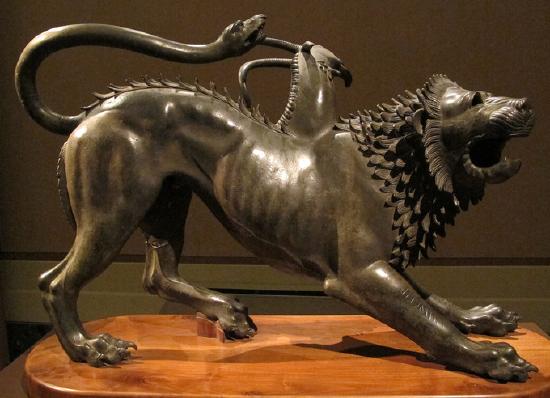
The bronze statue demonstrates Etruscan artistic techniques and how the liveliness seen in Etruscan terracotta sculpture is transmitted into the bronze medium. The figure is well modeled and expressive—from its tense muscles, ready pose, and roaring face of the lion and goat. The beast’s ribs are clearly visible and a wound on its rump bleeds. The lion’s posture—he crouches and looks up—suggests that there may have been an additional figure of Bellerophon to create a votive group. The figure’s face and mane is stylized and the patterning is reminiscent of Near Eastern depictions of lions.
Etruscan Art under Rome
In 509 BCE, the Etruscan kings of Rome were expelled from the city, and the Roman Republic was established. By the fourth century BCE, Rome was beginning to expand across the Italian peninsula, and the first Etruscan city to fall was Veii in 396 BCE.
Over the following centuries, Etruria was involved in Roman wars, and Etruscan territory was fully conquered by the Romans by the beginning of the first century BCE. While Roman culture drew from its Etruscan roots, borrowing and adapting Etruscan customs, Etruscan society was also influenced by Roman culture.
During this period, art begin to adopt a Roman style and display the permeation of Roman culture and values into Etruscan society. The threat of invasion also led to the common presence of violence, especially in funerary images.
Funerary Art and Sarcophagi
Funerary art, both in tomb paintings and on carved sarcophagi, underwent a noticeable change in subject matter during the Roman period. The figures of Charun and Vanth, demons of the underworld, were depicted with increasing regularity (see Figure 10.2.2).
Both figures are often depicted with wings, while Charun is often depicted with blue skin to signify putrefying flesh. They also carry torches, used to light the way to the underworld, or sometimes keys to open the door to the underworld, which underline the figures’ role as guides between the world of the living and the world of the dead. In the tomb paintings in Tarquinia, the figures of Charun and Vanth can be seen painted in front of or around doorways.
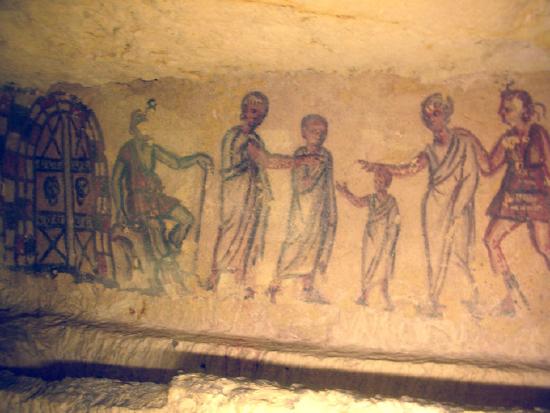
While Charun’s name is likely a derivative of the Greek underworld ferryman Charon, Vanth appears to be uniquely Etruscan. Due to Charun’s menacing associations, theories have attempted to associate Vanth with the avenging Greek Furies. However, her role as a benevolent guide conflicts with this suggestion.
Regardless of Vanth’s exact role and origins, the appearance of a less-than-joyous afterlife and menacing figures in Etruscan funerary art does not emerge until after the beginning of the Roman incursions into Etruscan territory. Perhaps Vanth is a gentler apotropaic figure, offering the reassurance of an ally in the afterlife to counteract the trials faced in the face of impending cultural collapse and absorption.
The Sarcophagus of Lars Pulena
Charun and Vanth also appear on stone and terracotta sarcophagi. Charun is also sometimes depicted with a hammer. On the Sarcophagus of Lars Pulena, two figures of Charun--with hammers but without wings, are depicted on either side of a central figure, most likely Lars Pulena, swinging their hammers at his head. The violent image might have been used as an apotropaic device to ward off evil (see Figure 10.2.3).
However, in comparison to earlier funerary images, the level of violence seems to mimic the new level of violence in Etruscan society from Roman forces and influence. Two winged representations of Vanth also appear on the sarcophagus, at either end of the frieze .
The lid of the sarcophagus depicts a portrait of the deceased. The man lies alone, wearing a somber expression, unlike the earlier terracotta Sarcophagus of the Spouses.
His face is wrinkled and reflects a Roman republican portrait style, which equates age with wisdom and leadership capabilities. He has a pot belly, signifying his wealth, good life, and robust eating, and he holds a scroll across his lap that is inscribed with a list of his accomplishments.
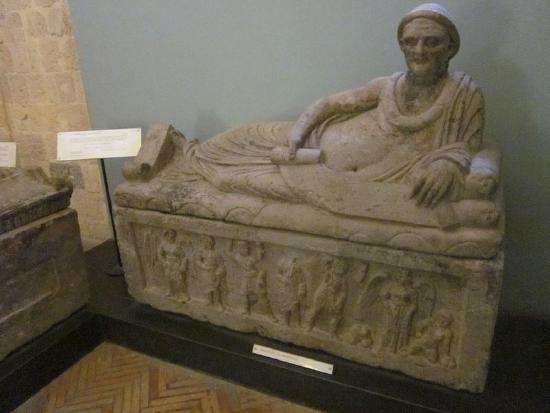
Smaller cinerary urns assumed the shapes of sarcophagi during this period (see Figure 10.2.4). These urns are topped with images of the deceased lying across the lid, often in Roman dress, with relief-carved scenes of battle, violence, or Charun and Vanth.
The woman who reclines atop the urn wears attire more akin to that of a Roman matron than to the woman on the Sarcophagus of the Spouses. Unlike the Etruscans, who buried their dead in tombs designed to mimic the appearance and comforts of private homes, the Romans practiced cremation and stored the ashes of their deceased in cinerary urns. This shift in Etruscan culture demonstrates the adoption of Roman funerary practices.
Historically, burials and tombs have offered great historical insight to archaeologists and art historians, though as mentioned in Chapter 4 (link to <<Global Connections: Native American Graves Protection and Repatriation Act>>), archaeological norms are changing in regards to preserving the sanctity of graves and returning sacred items to ancestors. Just as the Etruscan tombs help to illuminate their local history, many cultures worldwide also have customs and beliefs tied to mourning, death, and burials. People often make or commission finery to bury with important rulers and with their loved ones. Also known as “grave goods,” these items vary across cultures and geographies and are often intrinsically tied to both local spiritual beliefs and the person buried. The Moche Royal Tombs of Sipan, excavated by Peruvian archaeologist Walter Alva, included exquisite gold- and turquoise-laden jewelry, accessories, and figurines—all dating from different periods from about 300-700 BCE.
In China, numerous elaborate tomb structures speak to the importance of burying leaders, rulers, and loved ones with intricate grave goods. The tomb of Marquis Yi of Zeng State, discovered undisturbed in 1978, was carefully excavated to reveal more than 15,000 items, from musical instruments such as chime bells, to massive bronze vessels, to objects and serving dishes made of gold and jade, to lacquered coffins—all from the late 5th century BCE.
The rich Byzantine history of wearable art and jewelry extends to the burials of their deceased in elaborately decorated clothing, with woven designs and detailed borders. This clothing has been best preserved in late antique burials in Egypt, where the dry climate helped to preserve even the fabrics from the fifth century. Such finery has indicated to historians that by this time in Byzantine history, even families with moderate means dedicated their money to providing deceased loved ones with ornately decorated coats and clothing.
Bucchero
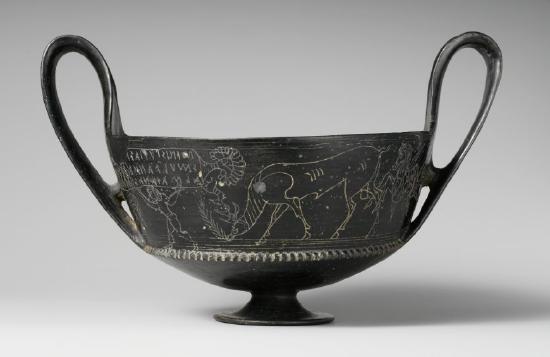
Bucchero, a distinctly black, burnished ceramic ware, is often considered the signature ceramic fabric of the Etruscans, an indigenous, pre-Roman people of the Italian peninsula. The term bucchero derives from the Spanish term búcaro (Portuguese: pucaro), meaning either a ceramic jar or a type of aromatic clay. The main period of bucchero production and use stretches from the seventh to the fifth centuries BCE. A tableware made mostly for elite consumption, bucchero pottery occupies a key position in our understanding of Etruscan material culture.
Manufacture
Bucchero’s distinctive black color results from its manufacturing process. The pottery is fired in a reducing atmosphere, meaning the amount of oxygen in the kiln’s firing chamber is restricted, resulting in the dark color. The oxygen-starved atmosphere of the kiln causes the iron oxide in the clay to give up its oxygen molecules, making the pottery darken in color. The fact that pottery was burnished (polished by rubbing) before firing creates the high, almost metallic, sheen. This lustrous, black finish is a hallmark of bucchero pottery. Another hallmark is the fine surface of the pottery, which results from the finely levigated (ground) clay used to make bucchero.

Bucchero wares may draw their inspiration from metalware vessels, particularly those crafted of silver, that would have been used as elite tablewares. The design of early bucchero ware seems to evoke the lines and crispness of metallic vessels; additionally early decorative patterns that rely on incision and rouletting (roller-stamping) also evoke metalliform design tendencies.
Forerunners of Etruscan bucchero
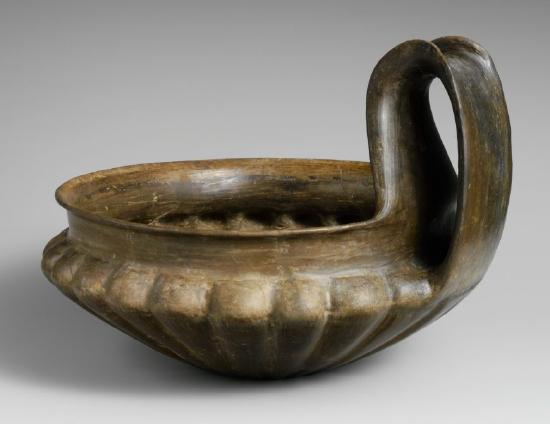
Impasto (a rough unrefined clay) ceramics produced by the Villanovan culture--the earliest Iron Age culture of central and northern Italy--were forerunners of Etruscan bucchero forms. Also called buccheroid impasto, they were the product of a kiln environment that allows for a preliminary phase of oxidation but then only a partial reduction, yielding a surface finish that ranges from dark brown to black, but with a section that remains fairly light in color. The kyathos in the Metropolitan Museum of Art (see Figure 10.2.7) provides a good example; the quality of potting is high overall. This impasto ware was thrown on the wheel, has a highly burnished surface, but has a less refined fabric (material) than later examples of true bucchero.
Bucchero types
Archaeologists have discovered bucchero in Etruria and Latium (modern Tuscany and northern Lazio) in central Italy; it is often frequently found in funereal contexts. Bucchero was also exported, in some cases, as examples have been found in southern France, the Aegean, North Africa, and Egypt.
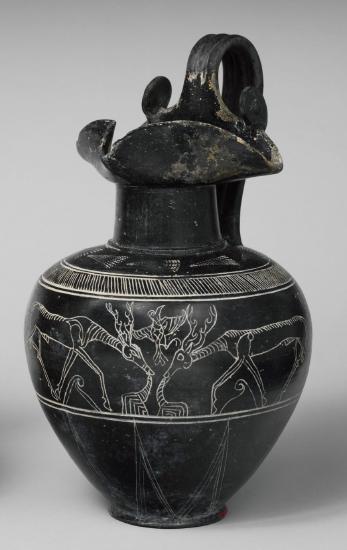
The production of bucchero is typically divided into three artistic phases. These are distinguishable on the basis of the quality and thickness of the fabric. The phases are: “thin-walled bucchero” (bucchero sottile), produced c. 675 to 626 BCE, “transitional,” produced c. 625 to 575 BCE, and “heavy bucchero” (bucchero pesante), produced from c. 575 to the beginning of the fifth century BCE.
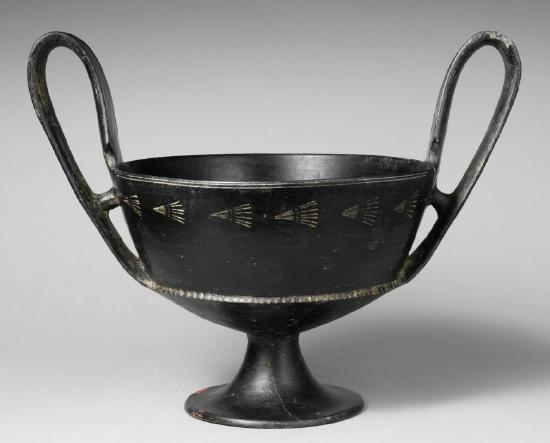
The earliest bucchero has been discovered in tombs at Caere (just northwest of Rome). Its extremely thin-walled construction and sharp features echo metallic prototypes. Decoration on the earliest examples is usually in the form of geometric incision, including chevrons and other linear motifs (see Figure 10.2.9). Roller stamp methods would later replace the incision.
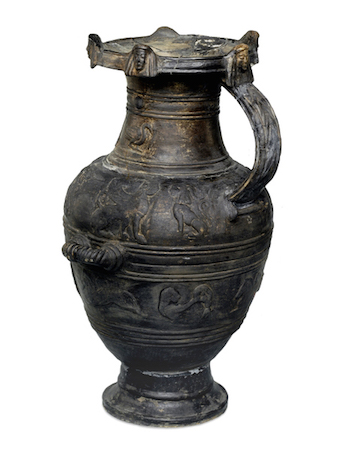
By the sixth century BCE, a “heavy” type of the ceramic had replaced the thin-walled bucchero. A hydria, or vessel used to carry water, in the British Museum (see Figure 10.2.10) is another example of the “heavy” bucchero of the sixth century BCE. This vessel has a series of female appliqué heads as well as other ornamentation. A tendency of the “heavy” type also included the use of mold-made techniques to create relief decoration.

A number of surviving bucchero examples carry incised inscriptions. A bucchero vessel currently in the collection of the Metropolitan Museum of Art (see Figure 10.2.11) provides an example of an abecedarium (the letters of the alphabet) inscribed on a ceramic vessel. This vase, in the form of a cockerel, dates to the second half of the seventh century B.C.E. has the 26 letters of the Etruscan alphabet inscribed around its belly (see Figure 10.2.12)—the vase combines practicality (it may have been used as an inkwell) with a touch of whimsy. It demonstrates the penchant of Etruscan potters for incision and the plastic modeling of ceramic forms.

Interpretation
Bucchero pottery represents a key source of information about the Etruscan civilization. Used by elites at banquets, bucchero demonstrates the tendencies of elite consumption among the Etruscans. The elite display at the banqueting table helped to reinforce social rank and to allow elites to advertise the achievements and status of themselves and their families.
Aule Metele (Arringatore)
by Dr. Jeffrey A. Becker
An Etruscan in Roman clothing, this figure is a masterwork—made as Etruscan culture was slipping away (see Figure 10.2.13). The image, status, and stature of the magistrate in the course of performing the duties of his office commands respect—and no pose is more riveting than that of the orator.
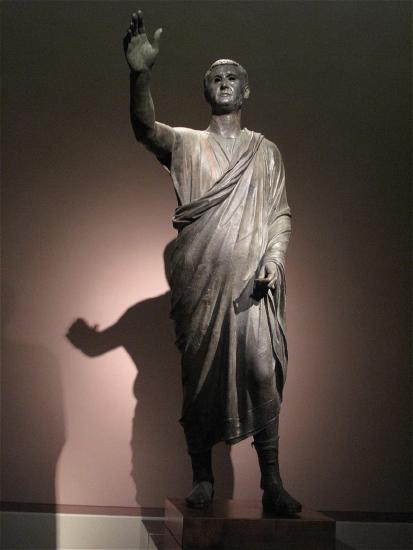
L’Arringatore (“The Orator”) is a hollow-cast bronze statue that was recovered from Lake Trasimeno in 1566. The statue is an important example of bronze sculpture in later first millennium B.C.E. Italy and indicates the gradual Romanization of Etruscan art.
The statue
The life-size statue depicts a draped adult male, standing with his right arm outstretched. The figure adopts a frontal pose with a slight contrapposto stance (contrapposto refers to the figure shifting his weight onto his right leg). Based on the inscription on the statue, the figure is identified as Aulus Metellus (or Aule Metele in Etruscan). He is clearly a magistrate and his posture seems to be that of the orator who is in the process of addressing the crowd. He wears a tunic over which is draped a toga—the formal attire of the magistrate. The toga is wrapped around the body, leaving the right arm free. On his feet are the high boots that were commonly worn by Roman senators. His expression and slightly opened mouth make him a compelling figure. The statue was originally erected by the community in honor of Aulus Metellus.
The inscription

The lower hem of the short toga carries an Etruscan inscription: “auleśi meteliś ve[luś] vesial clenśi / cen flereś tece sanśl tenine / tu θineś χisvlicś” which can be interpreted as reading, “To (or from) Auli Meteli, the son of Vel and Vesi, Tenine (?) set up this statue as a votive offering to Sans, by deliberation of the people” (TLE 651; CIE 4196; see Figure 10.2.14).
Interpretation
The statue of Aulus Metellus offers us a glimpse of the changing socio-political landscape of the Italian peninsula during the latter first millennium BCE—a period in which sweeping change brought on by the hegemonic fortunes of Rome and its booming population, signaled profound and lasting change for other Italic peoples, including the Etruscans. As Rome’s territory expanded during the fifth through first centuries BCE, her neighbors were gradually absorbed into the sphere of Roman cultural, economic, and political influence. Some groups, of course, resisted in one way or another, while others gladly “joined up” through political and military treaties and through adopting a Roman lifestyle. This process of acculturation–or Romanization, to use a term that is considered outmoded by some scholars—means that cultural heterogeneity becomes less visible in the archaeological record, replaced instead by a more homogeneous cultural model. These were the fortunes of the Etruscans—as the autonomy of the various Etruscan states eroded, the Etruscans themselves elected to adopt the trappings of a Roman culture that was, in turn, indicative of wider, pan-Mediterranean dynamics. Etruscan art, politics, and even language gradually slipped away.
Thus L’Arringatore is one of our latest surviving examples of a sculptural masterwork that still demonstrates the traits of an Etruscan workshop, all the while packaged for an increasingly Roman world. The statue clearly wears the short toga exigua, a kind of narrow toga, and senatorial boots that come from the Roman sphere. He is posed as an orator—highlighting his political career as both Etruscan and Roman aristocrats did. His haircut is in keeping with those of Roman aristocrats and his face may betray some evidence of the verism, or truthfulness, popular among Roman elites of the late Republic. The statue still carries an inscription in Etruscan, though, and the working of the bronze is in keeping with the tendencies of Etruscan craftsmanship. Surely the historical Aulus Metellus witnessed a world that was changing rapidly and this statue that carries his inscribed name still bears silent witness to the patterns and dynamics of socio-cultural change in the Roman Mediterranean.
Etruscan Necropolises of Cerveteri and Tarquinia (from UNESCO/NHK)
by UNESCO and Nippon Hoso Kyokai
Doors to the afterlife, Etruscan tombs were happily decorated. But as war increased, that began to change.
These two large Etruscan cemeteries reflect different types of burial practices from the 9th to the 1st century BCE, and bear witness to the achievements of Etruscan culture, which over nine centuries developed the earliest urban civilization in the northern Mediterranean. Some of the tombs are monumental, cut in rock and topped by impressive tumuli (burial mounds). Many feature carvings on their walls; others have wall paintings of outstanding quality. The necropolis near Cerveteri, known as Banditaccia, contains thousands of tombs organized in a city-like plan, with streets, small squares and neighborhoods. The site contains very different types of tombs: trenches cut in rock; tumuli; and some, also carved in rock, in the shape of huts or houses with a wealth of structural details. These provide the only surviving evidence of Etruscan residential architecture. The necropolis of Tarquinia, also known as Monterozzi, contains 6,000 graves cut in the rock. It is famous for its 200 painted tombs, the earliest of which date from the 7th century BCE.
Articles in this section:
- Boundless Art History. “Later Etruscan Art.”CC BY SA
- Dr. Jeffrey A. Becker, "Bucchero," in Smarthistory, August 8, 2015. (CC BY-NC-SA)
- UNESCO and Nippon Hoso Kyokai, "Etruscan Necropolises of Cerveteri and Tarquinia (from UNESCO/NHK)," in Smarthistory, December 21, 2015. (CC BY-NC-SA)

